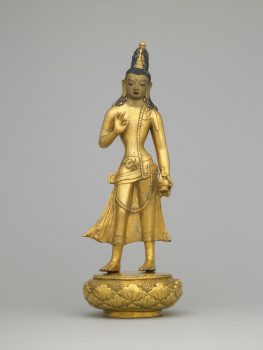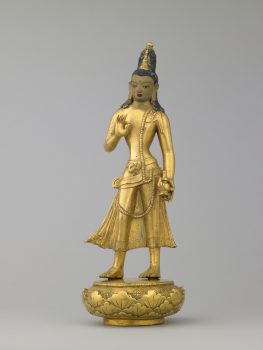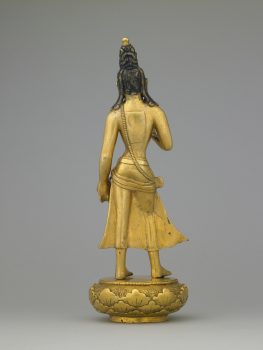Mongolia
19th century



Mongolia
19th century



Maitreya (Mongolian Mayidari), the Buddha of the Future, recognizable by the stupa in his hair, is a special focus of worship among the Mongols. The tradition’s promise of the coming of a new age was appealing among the Mongols, who linked it to their aspirations to reestablish the glory days of the Mongol Empire. This sculpture was modeled on a famous statue made by the great Mongolian sculptor Zanabazar (1635–1723), which was the focus of the annual Maitreya Festival procession, and thus well known to Mongolian artists. Inspired by Nepalese aesthetics, the soft sleekness of form broken by a subtle asymmetrical linear pattern of cords and sashes closely follows Zanabazar’s design. The distinctive drum-shaped lotus throne, with finely articulated leaves and stamen, is also a distinctive feature of Zanabazar’s style. The baseplate used to seal consecration materials is intact and is ornamented with a gilt crossed vajra (vishva-vajra) pattern characteristic of Mongolian works following in the tradition of Zanabazar.
In Buddhism time is perceived as relative, dynamic, and conceptual. This outlook highlights important principles of interdependence within Buddhist philosophy.
A vehicle for the preservation and transmission of knowledge. The Buddha’s teachings were originally passed down through oral transmission and storytelling, and stories of the Buddha’s past lives are considered an important source of inspiration and guidance.
An awakened being who understands the true nature of reality and is free from the cycle of birth, death, and rebirth. While there are many buddhas, Siddhartha Gautama is the historical Buddha, whose teachings became the foundation of Buddhism.
Mongolians have been widely active in the Tibetan Buddhist world, playing a key role in Tibetan culture, politics, and relations with China. In the 13th century, the Mongol Empire—the largest contiguous empire in world history—facilitated the spread of Tibetan visual culture.
Get the latest news and stories from the Rubin, plus occasional information on how to support our work.